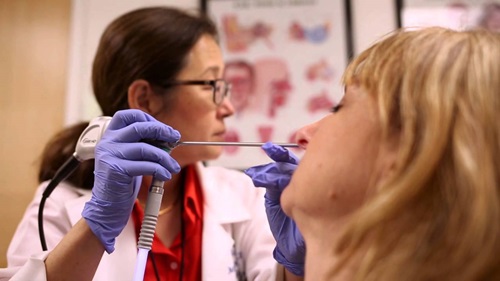Balloon Sinuplasty
What is balloon sinuplasty?
This minimally invasive technique is used to treat chronic or recurrent sinusitis or sinus infections when medical therapy has not provided adequate relief. During this procedure, surgeons use a small balloon, placed through the nose, to dilate the sinus openings. The results are permanent, and it does not require implants or additional support.
Who is a candidate for balloon sinuplasty?
Not everyone is a candidate. Good candidates for balloon sinuplasty include people who:
- Do not have nasal polyps or tumors
- Have a mild form of sinusitis
- Can tolerate the procedure under local anesthesia (the area is numb, but the patient remains awake throughout the procedure)
- Have an affected area in specific sinuses, including those in the cheeks (maxillary sinuses), forehead (frontal sinuses) or back of the nose (sphenoid sinuses)
The procedure is generally performed on adults. Children who have not responded to other treatments for sinusitis may be candidates for balloon sinuplasty, but only in limited scenarios.
If balloon sinuplasty is not the correct procedure for you, you may be a candidate for endoscopic sinus surgery, a minimally invasive outpatient surgical procedure also used to treat sinusitis. You and your doctor will discuss what is the right treatment.
Sinus Center

The Johns Hopkins Sinus Center provides state-of-the-art evaluation and treatment for a variety of nose and sinus conditions, including environmental allergies, nasal obstruction, nasal tumor and related disorders.
What should you expect during a sinuplasty procedure?
Sinuplasty is performed under general anesthesia, in the operating room or, for select patients, in the office using topical numbing medication. To perform the procedure, the surgeon threads a guidance wire through the nostril and into the sinus cavity opening, which is then followed by a small balloon. The balloon is inflated to enlarge the sinus opening, allowing the sinus cavity to drain better. Like endoscopic sinus surgery (link), sinuplasty does not require cutting through the skin — it is performed entirely through the nostrils. Most patients can go home the same day.
Balloon Sinuplasty Recovery
Following balloon sinuplasty, you can expect mild discomfort in the nose and nasal area, which generally can be treated with over-the-counter medication. You may also experience nasal drainage that might be discolored or might contain a little blood. During a few days after the procedure, you will maintain nasal hygiene with saline rinses that may contain medication prescribed by your surgeon. Saline rinses help flush out mucus and debris during the healing process and prevent infection, scarring or buildup of material in your nose.
Unlike sinus procedures that are more invasive, balloon sinuplasty (and endoscopic sinus surgery) does not leave visible scarring or bruising.
Nasal Congestion After Balloon Sinuplasty
As with any nasal procedure, you may experience nasal congestion after balloon sinuplasty. This congestion generally lasts a few days. Saline rinses help relieve congestion caused by mucus or debris.






